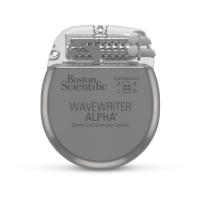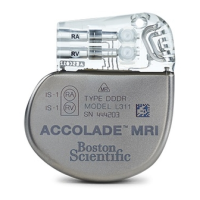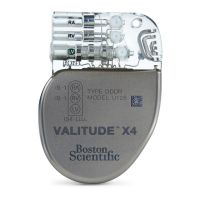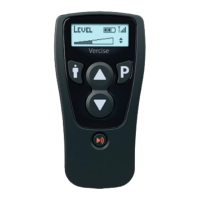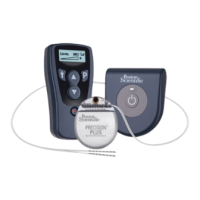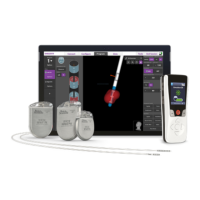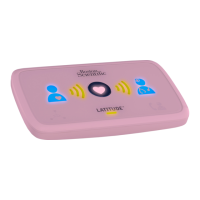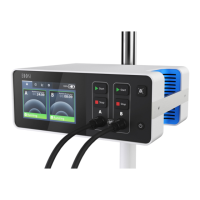Boston Scientific (Master Brand, Spiral Bound Manual Template, 8.5in x 11in Global, 92238518A), MB, AngioJet Ultra Sys, Oper Manual, en, 50779353-01A
Black (K) ∆E ≤5.0Black (K) ∆E ≤5.0
11
Check Saline Supply Alarm: A recoverable condition occurring when an abnormally
low pressure has been detected. Replacement of the Thrombectomy Set may
be necessary.
Collection Bag: The bag which collects the extracted thrombus being removed by the
catheter. The bag hangs on the Console drawer.
Control Panel: The operator interface on the upper front of the Console.
Error: A nonrecoverable fault which has occurred because of Thrombectomy Set or
Console malfunction.
Saline Delivery Tubing: The tubing which transports saline from the saline bag to
the pump.
Self-Test: An operation performed by the Console to examine the fidelity and the state
of its circuit paths and sensors. An appropriate indicator will be illuminated if any
abnormality is detected.
Thrombectomy Set: The disposable component of the AngioJet™ Thrombectomy
System which delivers pressurized saline and removes debris. It consists of the saline
bag spike, saline delivery tubing, pump, catheter, waste tubing, and collection bag.
Waste Tubing: The tubing which is inserted in the roller pump and transports the
extracted thrombus from the effluent tubing to the collection bag.
SPECIFICATIONS
Model Number 5000A
Dimensions, D x W x H 25 in x 16.5 in x 54 in
(63.5 cm x 42 cm x 137 cm)
Weight 140 lbs (63.5 kg)
Voltage requirements 100/120/220/240 VAC
Frequency requirements 50/60 Hz
Power requirements 900 VA
Logic power backup outage 60 seconds for conditions of powerloss
Equipment class Class 1
Degree of protection against
electrical shock
Defibrillation-Proof Type CF Applied Part
Enclosure protection against ingress
of liquid
IPX 1
Foot switch protection against
ingress of liquid
IPX 8
Mode of (electrical) operation Continuous
Transport temperature -25 °C to 55 °C (-13 °F to 131 °F)
Transport relative humidity 10% to 95% (noncondensing)
Transport atmospheric pressure 500 hPa to 1060 hPa
Storage temperature -25 °C to 55 °C (-13 °F to 131 °F)
Storage relative humidity 10% to 95% (noncondensing)
Storage atmospheric pressure 500 hPa to 1060 hPa
Operation temperature 10 °C to 40 °C (50 °F to 104 °F)
Operation humidity 30% to 75% (noncondensing)
Operation atmospheric pressure 700 hPa to 1060 hPa
Pollution No greater than degree 2
Installation/Overvoltage No greater than category 2
Fuse
100/120V, T10AL, 250V, 5 mm x 20 mm
220/240V, T6.3AL, 250V, 5 mm x 20 mm
Cables AC adapter cable
Maximum Cord Length 10 ft (3.05 m)
Foot Switch
Maximum Cord Length 15 ft (4.57 m)
The AngioJet Ultra Console is UL LLC Classified to
ANSI/AAMI ES60601-1:A1:2012, C1:2009/(R)2012 and A2:2010/(R)2012,
CSA CAN/CSA-C22.2 No. 60601-1:14; UL 60601-1, CAN/CSA C22.2 No. 601.1.
Note: If it becomes necessary to replace the fuse, replace fuse with the type and
rating specified. Failure to do so may result in device damage or risk of fire.
ELECTRONIC AND ELECTROMAGNETIC GUIDANCE
Table 1� Guidance and manufacturer’s declaration – electromagnetic emissions
The AngioJet System is intended for use in the electromagnetic environment specified
below. The customer or the user of the AngioJet System should assure that it is used in
such an environment.
Emissions Test Compliance Electromagnetic Environment –
Guidance
RF emissions
CISPR 11
Group 1
The AngioJet System uses
RF energy only for its internal
function. Therefore, its RF
emissions are very low and
are not likely to cause any
interference in nearby electronic
equipment.
RF emissions
CISPR 11
Class A
The AngioJet System is suitable
for use in all establishments
other than domestic and those
directly connected to the public
low-voltage power supply
network that supplies buildings
used for domestic purposes.
Harmonic emissions
IEC 61000-3-2
Class A
Voltage fluctuations flicker/
emissions
IEC 61000-3-3
Complies
NOTE: The emissions characteristics of this equipment make it suitable for use
in industrial areas and hospitals (CISPR 11 class A). If it is used in a residential
environment (for which CISPR 11 class B is normally required) this equipment
might not offer adequate protection to radio-frequency communication services.
The user might need to take mitigation measures, such as relocating or
re-orienting the equipment.

